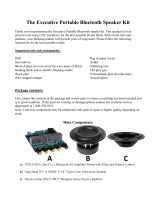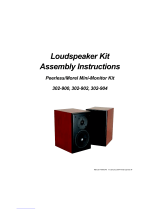
22) Place the acrylic mounting plate onto the inside of the back panel of the enclosure in the
matching recess. Secure into place using 4 x #8 x 1/2" Deep Thread Pan Head Screws and 4 x nylon
washers through the pre-drilled holes in the mounting plate and back panel (do not over tighten). A
screwdriver can be inserted through the tweeter hole in the front panel for easy access.
23) Connect the wires from the DC jack to the Dayton Audio LBB-3v3 3 x 18650 Lithium Battery
Charger Board/Module by stabbing the stripped ends of the red and black Consolidated 22 AWG Solid
Hook-Up Wire into the connector labeled DC INPUT: 5-24V on the end of the battery charger board,
red wire to + and black wire to -. Note: You can depress the small indentation on the connector to
release the wires if needed.
24) Unscrew the plastic knob on the binding posts inside the enclosure and insert the ends of the
woofer output wires through the holes in the sides of the binding posts (red to red and black to
black). Tighten the plastic knobs on each binding post securely. Double check that each wire is
securely held in place.
25) Connect the 0.205" connectors on the wires inside one of the sub enclosures to the corresponding
connectors on one of the Dayton Audio DSA90-8 3" Designer Series Aluminum Cone Full-Range Drivers
red to + (marked with a red dot) and black to -. Carefully place the driver into the opening in the sub-
enclosure (it will be a tight fit, hold the terminals against the magnet and gently work the driver into the
opening). Secure the driver in place using 4 x #6 x 3/4" Deep Thread Pan Head Screws being careful not
to strip out the holes (a power drill is not recommended). Repeat for the other side.
26) Pull the tweeter wires through the tweeter opening and crimp a 0.205" blue female disconnect to
each red wire and a 0.11" blue female disconnect to each wire. Connect the connectors from one wire to
the corresponding terminals on one of the Dayton Audio ND25TA-4 1" Titanium Dome Neodymium
Tweeters. Carefully place the tweeter into its opening and secure the tweeter in place using 4 x #6 x 3/4"
Deep Thread Pan Head Screws being careful not to strip out the holes (a power drill is not recommended).
Repeat for the other side.
27) Cut a 6" – 8" piece of red/black speaker wire and strip 1/4" of insulation from each conductor on
one end of the wire and 3/4” of insulation from the other end. Insert the shorter stripped ends of the wire
into the terminals on the back of the amplifier board labeled BASS, (red to + and black to -). Ensure the
no strands of the wires are exposed from the terminal and secure wire in place using a small flat head
screwdriver.






















